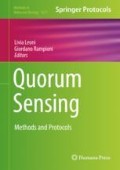Abstract
In Streptomyces, the onset of antibiotic production and sporulation is coordinated through small diffusible molecules known as γ-butyrolactones (GBLs). These are active in very low amounts, and their extraction and characterization are challenging. Here we describe a rapid, small-scale method for the extraction of GBL from Streptomyces coelicolor, from both solid and liquid cultures, which provides sufficient material for subsequent bioassays and partial characterization. We also present two different bioassay techniques for the detection and quantification of the GBL content in the extracts: the antibiotic bioassay and the kanamycin bioassay.
Access this chapter
Tax calculation will be finalised at checkout
Purchases are for personal use only
References
Cimermancic P, Medema MH, Claesen J, Kurita K, Wieland Brown LC, Mavrommatis K et al (2014) Insights into secondary metabolism from a global analysis of prokaryotic biosynthetic gene clusters. Cell 158:412–421
Biarnes-Carrera M, Breitling R, Takano E (2015) Butyrolactone signalling circuits for synthetic biology. Curr Opin Chem Biol 28:91–98
Kato J, Funa N, Watanabe H, Ohnishi Y, Horinouchi S (2007) Biosynthesis of γ-butyrolactone autoregulators that switch on secondary metabolism and morphological development in Streptomyces. Proc Natl Acad Sci USA 104:2378–2383
Niu G, Chater KF, Tian Y, Zhang J, Tan H (2016) Specialised metabolites regulating antibiotic biosynthesis in Streptomyces spp. FEMS Microbiol Rev 40:554–573
Choi SU, Lee CK, Hwang YI, Kinosita H, Nihira T (2003) Gamma-butyrolactone autoregulators and receptor proteins in non-Streptomyces actinomycetes producing commercially important secondary metabolites. Arch Microbiol 180:303–307
Takano E (2006) Gamma-butyrolactones: Streptomyces signalling molecules regulating antibiotic production and differentiation. Curr Opin Chem Biol 9:287–294
Recio E, Colinas A, Rumbero A, Aparicio JF, Martín JF (2004) PI factor, a novel type quorum sensing inducer elicits primaricin production in Streptomyces natalensis. J Biol Chem 279:41586–41593
Zou Z, Du D, Zhang Y, Zhang J, Niu G, Tan H (2014) A γ-butyrolactone-sensing activator/repressor, JadR3, controls a regulatory mini-network for jadomycin biosynthesis. Mol Microbiol 94:490–505
Takano E, Chakraburtty R, Nihira T, Yamada Y, Bibb MJ (2001) A complex role for the γ-butyrolactone SCB1 in regulating antibiotic production in Streptomyces coelicolor. Mol Microbiol 41:1015–1028
Corre C, Song L, O'Rourke S, Chater KF, Challis GL (2008) 2-alkyl-4-hydroxymethylfuran-3-carboxylic acids, antibiotic production inducers discovered by Streptomyces coelicolor genome mining. Proc Natl Acad Sci USA 105:17510–17515
Wang J, Wang W, Wang L, Zhang G, Fan K, Tan H et al (2011) A novel role of ‘pseudo’γ-butyrolactone receptors in controlling γ-butyrolactone biosynthesis in Streptomyces. Mol Microbiol 82:236–250
Takano E, Nihira T, Hara Y, Jones JJ, Gershater CJ, Yamada Y et al (2000) Purification and structural determination of SCB1, a gamma-butyrolactone that elicits antibiotic production in Streptomyces coelicolor A3(2). J Biol Chem 275:11010–11016
Hsiao NH, Nakayama S, Merlo ME, de Vries M, Bunet R, Kitani S et al (2009) Analysis of two additional signaling molecules in Streptomyces coelicolor and the development of a butyrolactone-specific reporter system. Chem Biol 16:951–960
Ohnishi Y, Kameyama S, Onaka H, Horinouchi S (1999) The A-factor regulatory cascade leading to streptomycin biosynthesis in Streptomyces griseus: identification of a target gene of the A-factor receptor. Mol Microbiol 34:102–111
Takano E, Kinoshita H, Mersinias V, Bucca G, Hotchkiss G, Nihira T et al (2005) A bacterial hormone (the SCB1) directly controls the expression of a pathway-specific regulatory gene in the cryptic type I polyketide biosynthetic gene cluster of Streptomyces coelicolor. Mol Microbiol 56:465–479
Pawlik K, Kotowska M, Chater KF, Kuczek K, Takano E (2007) A cryptic type I polyketide synthase (cpk) gene cluster in Streptomyces coelicolor A3(2). Arch Microbiol 187:87–99
Kieser T, Bibb MJ, Buttner MJ, Chater KF, Hopwood DA (2000) Practical Streptomyces genetics. Norwich, UK
Sidda JD, Poon V, Song L, Wang W, Yang K, Corre C (2016) Overproduction and identification of butyrolactones SCB1-8 in the antibiotic production superhost Streptomyces M1152. Org Biomol Chem 14:6390–6393
Nakano H, Takehara E, Nihira T, Yamada Y (1999) Gene replacement analysis of theStreptomyces virginiae barA gene encoding the butyrolactone autoregulator receptor reveals that BarA acts as a repressor in virginiamycin biosynthesis. J Bacteriol 180:3317–3322
Author information
Authors and Affiliations
Corresponding author
Editor information
Editors and Affiliations
Rights and permissions
Copyright information
© 2018 Springer Science+Business Media LLC
About this protocol
Cite this protocol
Biarnes-Carrera, M., Breitling, R., Takano, E. (2018). Detection and Quantification of Butyrolactones from Streptomyces . In: Leoni, L., Rampioni, G. (eds) Quorum Sensing. Methods in Molecular Biology, vol 1673. Humana Press, New York, NY. https://doi.org/10.1007/978-1-4939-7309-5_10
Download citation
DOI: https://doi.org/10.1007/978-1-4939-7309-5_10
Published:
Publisher Name: Humana Press, New York, NY
Print ISBN: 978-1-4939-7308-8
Online ISBN: 978-1-4939-7309-5
eBook Packages: Springer Protocols

